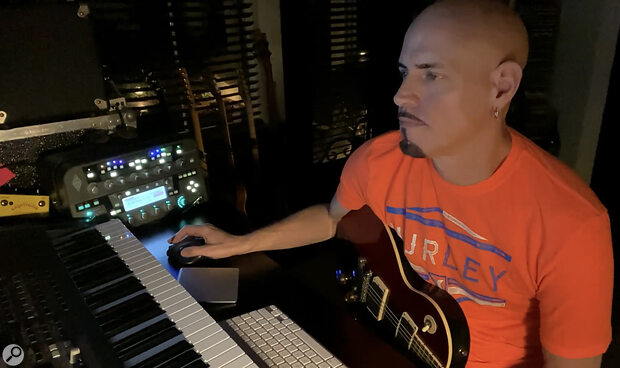 Fuel's Carl Bell in his studio.
Fuel's Carl Bell in his studio.
Carl Bell is guitarist and songwriter from American post‑grunge rockers Fuel, while producer Ben Grosse has worked with the likes of Dream Theater, Disturbed and Thirty Seconds To Mars, to name but a few. Their favourite of the many sounds they’ve created together is a solo on ‘Solace’ from Fuel’s second album, Something Like Human (2000).
 Carl Bell: “In the middle of the song ‘Solace’ there’s this solo section where you hear this strange ‘wo‑ah, wo‑ah’ kind of folding sound. That was created using a small DigiTech Talker pedal in a very unorthodox way, where it was kind of imitating a voice box. Instead of speaking into the microphone, it had an option where you could get a microphone and plug it in and with that, you could change the sound with the microphone. And so what we did was, instead of changing it with a voice, we turned it around to face the nearfield monitors in the studio and we just let the track kind of mess with the sound and that’s how we achieved it. It was a very cool technique and we got some weird sounds happening.”
Carl Bell: “In the middle of the song ‘Solace’ there’s this solo section where you hear this strange ‘wo‑ah, wo‑ah’ kind of folding sound. That was created using a small DigiTech Talker pedal in a very unorthodox way, where it was kind of imitating a voice box. Instead of speaking into the microphone, it had an option where you could get a microphone and plug it in and with that, you could change the sound with the microphone. And so what we did was, instead of changing it with a voice, we turned it around to face the nearfield monitors in the studio and we just let the track kind of mess with the sound and that’s how we achieved it. It was a very cool technique and we got some weird sounds happening.”
Ben Grosse: “As far as I remember this track was done in Los Angeles at my studio The Mix Room, but we did do some solo guitar tracking at Sear Sound in New York as well, so there’s a small chance that’s where it was done — I always have my guitar boxes with me when I travel. That said, I seem to remember swinging the mic around in Studio A at The Mix Room for this. I’m sure I did some EQ’ing, but with this being now more than 20 years ago, I can’t remember the specifics.
“The DigiTech box we used for this particular track had a mode where you could switch it to become a vocoder. I ran the guitar signal through the box before it went to the amp. Then I took a Shure SM57 and plugged that into the voltage control input and had the microphone placed on a boom, and as I swung the boom around towards the studio monitors, it would envelope in a really great way, and it also would respond to the volume peaks, for example from the drums, and give the envelope some pulse. As I moved the mic closer it would envelope up almost sounding like a wah‑wah pedal. That way I could control the envelope, along with the pulse of the song adding to it as well.”
